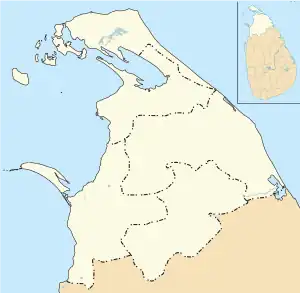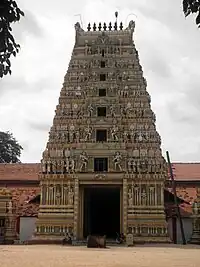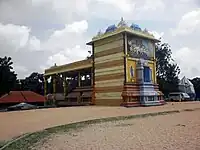Vallipuram
Vallipuram (Tamil: வல்லிபுரம், romanized: Vallipuram, Sinhala: වල්ලිපුරම, romanized: Vallipurama) is a village in Vadamarachchi, near Point Pedro in Northern Province, Sri Lanka.[1] The village is an ancient settlement with rich archeological remains.[2] The village is home to the Vishnu temple Vallipuram Aalvar Kovil.[3]
Vallipuram
வல்லிபுரம் වල්ලිපුරම | |
|---|---|
 Vallipuram | |
| Coordinates: 9°47′0″N 80°14′0″E | |
| Country | Sri Lanka |
| Province | Northern |
| District | Jaffna |
| DS Division | Vadamarachchi North |
| Population | |
| • Total | 596 |
History
A 2nd century gold plate carrying a Prakrit inscription was found under the foundation of the Vishnu Hindu temple at Vallipuram.[4] It mentions about the establishment of a Vihara in Nakadiva by the minister named Isigiraya under the ruler King Vaha who is identified as King Vasabha (67-111 C.E.).[4][5] The inscription is important as it confirms that King Vasabha was ruling the whole country including Nakadiva (According to Malini Dias, Nakadiva in Old Sinhala is the equivalent of Pali Nagadipa,[note 1] whilst the use of the phoneme 'k' to represent 'g' reveals Dravidian influence).[note 2][note 3][note 4]
The language and interpretation of the inscription is disputed.[note 5] According to Senarath Paranavithana, this is an inscription written in Old Sinhalese.[4] Peter Schalk believes that this inscription is in Prakrit bearing Dravidian influences and that the name Nakadiva is a fiefdom corresponding to modern Jaffna Peninsula, which was ruled under the minister Isikiraya ('raya' being a Tamil form of the word raja, and the place name 'Badakara' (vada karai - Tamil) deriving from the Dravidian 'northern coast').[10][11][12]
The exact details of the temple complex are not known, and the famous Vallipuram Buddha statue from the 3rd–4th century AD built in the Amaravathi style was found under the Vallipuram temple.[13] This cultural exchange between the Jaffna peninsula and Andhra Pradesh occurred at the height of trade in the Sangam period, continuing when the Telugu Satavahana dynasty was at the height of its power from 230 BC right through when its 17th monarch Hāla (20-24 AD) married a princess from the island.[10][14] Professor Peter Schalk (University of Uppsala), writes "Vallipuram has very rich archaeological remains that point at an early settlement. It was probably an emporium in the first centuries AD. […].[13] The Buddha statue found here was given to King of Thailand by the then British Governor Henry Blake in 1906.
Gallery
 Vallipuram
Vallipuram Vishnu temple, Vallipuram
Vishnu temple, Vallipuram Gold inscription of King Vasaha, Vallipuram
Gold inscription of King Vasaha, Vallipuram
1st century AC Brahmi:"Sidha! Maharaja-Vahayaha rajahi amete Isigiraye Nakadiva Bujameni Badakara-atanehi Piyaguka-Tisa Vihara karite"
Trans: Success! in the reign of the great king Vaha, when the minister Isigiraya was governing the Nakadiva, Piyaguka Tissa caused a Vihara to be built at Badakara Atana.[15]
Notes
- The inscription documented during the reign of King Vasabha records the building of a vihara or a monastery at a place called Badakara Atana by a person named Piyagukatisa, when the minister Isigiraya as the Governor of Nagadipa. Nakadiva in Old Sinhala is the equivalent of Pali Nagadipa. The gold plate bearing the inscription was discovered under the foundation of the Vishnu temple at Vallipuram in the Vadamarachchi Divisional Secretariat in Jaffna where remains the ruins of buildings of an early Buddhist civilization that flourished in the Northern part of Sri Lanka. According to the inscription, the fact that the King had a minister controlling the North in his reign, confirms that the whole of Sri Lanka was under King Vasabha[5]
- "The term Nakadiva in the script is partially Tamilised. It is an intermediate form between the Pali Nagadipa and the Tamil form Nakativu."[6]
- "Senarat Paranavitana correctly identifies Nakadiva with the Pali Nagadipa. The present writer feels that this form is partially Tamilised and is an intermediate form between the Pali form and the fully Tamilised form of Nakativu."[7]
- "Another feature that Sri Lankan Prakrit shares with Tamil is the interchangeability of ka and ga sounds. The word naka used in place of naga in this inscription itself exemplifies this relationship. These features clearly point to the importance of influences emanating from the southern parts of the Indian subcontinent on the development of the variety of Prakrit used in Sri Lanka."[8]
- "Having gone through the words in this inscription and having seen the Tamil background of several terms, we question the statement by Paranavitana that the language is old Sinhalese conforming, in general, to the grammatical standards followed in other documents of that period. We can see that there is a Tamil substratum and that there are some rather crude Prakritisations of Tamil words in the text."[9]
References
- "Census of Population and Housing 2012: Population by GN division and sex 2012" (PDF). Department of Census and Statistics, Sri Lanka. 2012.
- Journal of the Institute of Asian Studies. Institute of Asian Studies. 1994. p. 118.
- Samuel, G. John; Śivagaṇēśamūrti, Ār Es; Nagarajan, M. S. (1998). Buddhism in Tamil Nadu: Collected Papers. Institute of Asian Studies. p. 60.
- Paranavitana, S. (1983). Inscriptions of Ceylon, Late Brahmi Inscriptions, 2 (part 1). Colombo: Archaeological Survey of Sri Lanka. pp. 79, 81.
- Dias, M.; Koralage, S.B.; Asanga, K. (2016). The archaeological heritage of Jaffna peninsula. Colombo: Department of Archaeology (Sri Lanka). pp. 166, 167. ISBN 978-955-9159-99-5.
- Thiagarajah, Siva (2016). Kantarodai Civilization of Ancient Jaffna 500 BCE - 800 CE: A Study in Archaeology and Other Disciplines. Kumaran Book House. p. 123.
- Veluppillai, A. (2002). Buddhism among Tamils in pre-colonial Tamilakam and Īlam: Prologue. The Pre-Pallava and the Pallava period. Almqvist & Wiksell. p. 232. ISBN 9789155453572.
- Gunawardana, R.A.L.H (1995). Historiography in a Time of Ethnic Conflict: Construction of the Past in Contemporary Sri Lanka. Social Scientists’ Association, Colombo.
- SERENDIPITY - ISSUE 02 - THE VALLIPURAM BUDDHA IMAGE - AGAIN - Peter Schalk http://www.worldgenweb.org/lkawgw/vallipuram.html
- Schalk, Peter; Veluppillai, A.; Nākacāmi, Irāmaccantiran̲ (2002). Buddhism among Tamils in pre-colonial Tamilakam and Īlam: Prologue. The Pre-Pallava and the Pallava period. Almqvist & Wiksell. pp. 151, 221, 231. ISBN 9789155453572.
- Dravidian Etymology Dictionary - entry 5281 - https://dsal.uchicago.edu/cgi-bin/app/burrow_query.py?qs=vaṭa&searchhws=yes&matchtype=exact
- Dravidian Etymology Dictionary - entry 1293 - https://dsal.uchicago.edu/cgi-bin/app/burrow_query.py?qs=karai&searchhws=yes&matchtype=exact
- Schalk, Peter (1996-01-01). "The Vallipuram Buddha Image "Rediscovered"". Scripta Instituti Donneriani Aboensis. 16: 301. doi:10.30674/scripta.67235. ISSN 2343-4937.
- Ponnampalam Ragupathy. (1987). Early settlements in Jaffna: an archaeological survey. pp. 183
- Schalk, Peter; Veluppillai, A.; Nākacāmi, Irāmaccantiran̲ (2002). Buddhism among Tamils in pre-colonial Tamilakam and Īlam: Prologue. The Pre-Pallava and the Pallava period. Almqvist & Wiksell. pp. 151, 221, 231. ISBN 9789155453572.